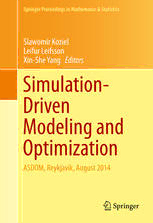Table Of ContentSpringer Proceedings in Mathematics & Statistics
Slawomir Koziel
Leifur Leifsson
Xin-She Yang Editors
Simulation-
Driven
Modeling and
Optimization
ASDOM, Reykjavik, August 2014
Springer Proceedings in Mathematics & Statistics
Volume 153
Moreinformationaboutthisseriesathttp://www.springer.com/series/10533
Springer Proceedings in Mathematics & Statistics
Thisbookseriesfeaturesvolumescomposedofselectcontributionsfromworkshops
and conferences in all areas of current research in mathematics and statistics,
includingORandoptimization.Inadditiontoanoverallevaluationoftheinterest,
scientific quality, and timeliness of each proposal at the hands of the publisher,
individual contributions are all refereed to the high quality standards of leading
journals in the field. Thus, this series provides the research community with
well-edited, authoritative reports on developments in the most exciting areas of
mathematicalandstatisticalresearchtoday.
Slawomir Koziel • Leifur Leifsson
Xin-She Yang
Editors
Simulation-Driven Modeling
and Optimization
ASDOM, Reykjavik, August 2014
123
Editors
SlawomirKoziel LeifurLeifsson
EngineeringOptimization DepartmentofAerospaceEngineering
&ModelingCenter CollegeofEngineering
ReykjavikUniversity IowaStateUniversity
Reykjavik,Iceland Ames,Iowa,USA
Xin-SheYang
SchoolofScienceandTechnology
MiddlesexUniversity
London,UnitedKingdom
ISSN2194-1009 ISSN2194-1017 (electronic)
SpringerProceedingsinMathematics&Statistics
ISBN978-3-319-27515-4 ISBN978-3-319-27517-8 (eBook)
DOI10.1007/978-3-319-27517-8
LibraryofCongressControlNumber:2015960792
SpringerChamHeidelbergNewYorkDordrechtLondon
©SpringerInternationalPublishingSwitzerland2016
Thisworkissubjecttocopyright.AllrightsarereservedbythePublisher,whetherthewholeorpartof
thematerialisconcerned,specificallytherightsoftranslation,reprinting,reuseofillustrations,recitation,
broadcasting,reproductiononmicrofilmsorinanyotherphysicalway,andtransmissionorinformation
storageandretrieval,electronicadaptation,computersoftware,orbysimilarordissimilarmethodology
nowknownorhereafterdeveloped.
Theuseofgeneraldescriptivenames,registerednames,trademarks,servicemarks,etc.inthispublication
doesnotimply,evenintheabsenceofaspecificstatement,thatsuchnamesareexemptfromtherelevant
protectivelawsandregulationsandthereforefreeforgeneraluse.
Thepublisher,theauthorsandtheeditorsaresafetoassumethattheadviceandinformationinthisbook
arebelievedtobetrueandaccurateatthedateofpublication.Neitherthepublishernortheauthorsor
theeditorsgiveawarranty,expressorimplied,withrespecttothematerialcontainedhereinorforany
errorsoromissionsthatmayhavebeenmade.
Printedonacid-freepaper
SpringerInternational PublishingAGSwitzerlandispartofSpringerScience+Business Media(www.
springer.com)
Preface
Accurate modeling and simulation of complex systems often necessitates highly
sophisticated but very computationally expensive models, and the costs and time
of computational simulations can pose challenging issues in many applications.
In addition, the search for optimum designs requires multiple simulation-design
cycles,oftenfromhundredstothousandsofevaluationsofdesignobjectives,which
makesmodelingandoptimizationtasksextremelychallengingandtime-consuming.
Among these challenges, a serious bottleneck for realizing an efficient design
optimization process is the high cost of computer simulations with simulation
times varying from hours to weeks or even months for large complex systems,
which means that even a single set of simulations can be very costly. For a
typicaldesign process, differentdesign optionsmay require manyvalidationsand
verifications using computer models in order to test “what-if” scenarios so as to
providedecision-makerswithrobust,realisticdesignoptions.Thoughthespeedof
thecomputerpowerhassteadilyincreasedoverpastdecades,however,suchspeed
increasecan slightlyease onlypartof the modelingandsimulationproblems,and
these challenging issues still remain largely unresolved.One of the reasons is the
ever-increasing demand of the high-accuracy, high-fidelity models for simulating
complexsystems.
In addition, the search for more sustainable optimum designs makes such
simulationtasksmorechallengingtosolve.Evenwithagoodsimulationmodel,the
numberofevaluationsandvalidationsofdesignobjectivescanbeveryhigh,varying
from several hundreds to thousands or even millions of objective calls. In many
cases,suchoptimizationproblemscanbeNP-hard,andthusnoefficientalgorithms
exist.Therefore,sometradeoffisneededinpracticetobalancethesolutionaccuracy
andpracticalityofsimulationanddesigns.
Furthermore,for many applicationsin aerospaceengineering,microwaveengi-
neering, gas transport networks, waste management, and system engineering,
alternativemethodsorapproximationsmethodsare oftenused.A classofapprox-
imation techniques and alternative approaches are the surrogate-based modeling,
simulation-driven design optimization, and metaheuristic optimization methods.
These surrogate-based and simulation-driven approaches provide the possibility
v
vi Preface
of using faster and cheaper surrogate models to represent expensive models with
adequate accuracy and sufficiently reduced simulation times, which consequently
makesmanycomplexdesignoptimizationtaskssolvableandachievableinpractice.
Amongallthekeyissuesandtechniques,themainaimsarethreefold:toincrease
the accuracy of modeling and simulation, to reduce the simulation and design
time, and to come up with more robust and sustainable design options. First, to
getmoreaccuratesimulationresults,sophisticatedsurrogatemodelsareneededto
provide near high-fidelity results; this usually requires many sampling points in
the search space in order to produce highly representative surrogates, which will
indirectly increase the computationalcosts. Second, in order to reduce simulation
and design time, efficient optimization algorithms are needed in addition to the
efficient approximate surrogate models. Traditional algorithms such as gradient-
basedmethodsandtrust-regionmethodsdonotworkwell.Thus,newmethodssuch
asthosebasedonswarmintelligencemethodscanbepromising.Inreality,agood
combinationofnewmethodswiththeexistingtraditionalmethodscanoftenobtain
goodresults.Finally,researchersanddesignershavetocombineallthetechniques
andresourcessoastoproducerobustandsustainabledesignoptions.Somedesign
options may satisfy all the design requirements, but they may be very sensitive
to manufacturing errors, and they may not be sustainable. Thus, designers often
haveto producea diverseset of designoptionsand thusallow decision-makersto
choose the most suitable design options under given stringent design constraints.
Anysuccessfuldesigncyclerequirestodealwiththeabovethreechallengingissues
withsufficientaccuracyinapracticallyacceptabletimelimit.
Thiseditedbookprovidesatimelysummaryofsomeofthelatestdevelopments
inmodelingandsimulation-drivendesignoptimization.Topicsincludeaerodynamic
optimization,gastransportnetworks,antennadesigns,microwavestructures,filter
designs, waste management, system identification, crystal nanostructures, sparse
grids,andothercomputationallyextensivedesignapplications.Therefore,thisbook
can serve as a reference to researchers, lecturers, and engineers in engineering
design, modeling, and optimization as well as industry where computationally
expensive designs are most relevant. It is our hope that this may help researchers
and designs to produce better design tools so as to reduce the costs of the design
processaidedbycomputersimulations.
Reykjavik,Iceland SlawomirKoziel
Ames,IA,USA LeifurLeifsson
London,UK Xin-SheYang
October2015
Contents
Numerical Aspects of Model Order Reduction for Gas
TransportationNetworks........................................................ 1
SaraGrundel,NilsHornung,andSarahRoggendorf
ParameterStudiesforEnergyNetworkswithExamplesfrom
GasTransport .................................................................... 29
TanjaClees
Fast Multi-Objective Aerodynamic Optimization Using
Space-Mapping-CorrectedMulti-FidelityModelsandKriging
Interpolation...................................................................... 55
Leifur Leifsson, Slawomir Koziel, Yonatan Tesfahunegn,
andAdrianBekasiewicz
AssessmentofInverseandDirectMethodsforAirfoilandWingDesign.. 75
MengmengZhangandArthurWilliamRizzi
PerformanceOptimizationofEBG-BasedCommonMode
FiltersforSignalIntegrityApplications....................................... 111
CarloOlivieri,FrancescodePaulis,AntonioOrlandi,andSlawomir
Koziel
Unattended Design of Wideband Planar Filters Using
aTwo-StepAggressiveSpaceMapping(ASM)OptimizationAlgorithm.. 135
MarcSans,JordiSelga,AnaRodríguez,ParisVélez,VicenteE.
Boria,JordiBonache,andFerranMartín
Two-Stage Gaussian Process Modeling of Microwave
StructuresforDesignOptimization............................................ 161
J.PieterJacobsandSlawomirKoziel
EfficientReconfigurableMicrostripPatchAntennaModeling
ExploitingKnowledgeBasedArtificialNeuralNetworks ................... 185
MuratSimsekandAshrfAoad
vii
viii Contents
Expedited Simulation-Driven Multi-Objective Design
OptimizationofQuasi-IsotropicDielectricResonatorAntenna............ 207
AdrianBekasiewicz,SlawomirKoziel,
WlodzimierzZieniutycz,andLeifurLeifsson
OptimalDesignofPhotonicCrystalNanostructures ........................ 233
Abdel-KarimS.O. Hassan, NadiaH. Rafat, andAhmedS.A.
Mohamed
DesignOptimizationofLNAs andReflectarrayAntennas
UsingtheFull-WaveSimulation-BasedArtificialIntelligence
ModelswiththeNovelMetaheuristicAlgorithms............................ 261
FilizGünes¸,SalihDemirel,andSelahattinNesil
StochasticDecision-Making inWasteManagement Using
a Firefly Algorithm-Driven Simulation-Optimization
ApproachforGeneratingAlternatives ........................................ 299
RahaImanirad,Xin-SheYang,andJulianScottYeomans
Linear and Nonlinear System Identification Using
EvolutionaryOptimisation...................................................... 325
K. Worden, I. Antoniadou, O.D. Tiboaca, G. Manson,
andR.J.Barthorpe
A Surrogate-Model-AssistedEvolutionaryAlgorithmfor
ComputationallyExpensive DesignOptimizationProblems
withInequalityConstraints..................................................... 347
BoLiu,QingfuZhang,andGeorgesGielen
SobolIndicesforDimensionAdaptivityinSparseGrids.................... 371
Richard P. Dwight, Stijn G.L. Desmedt,
andPejmanShoeibiOmrani
Index............................................................................... 397
Numerical Aspects of Model Order Reduction
for Gas Transportation Networks
SaraGrundel,NilsHornung,andSarahRoggendorf
Abstract Thechapterfocusesonthenumericalsolutionofparametrizedunsteady
Eulerian flow of compressible real gas in pipeline distribution networks. Such
problemscanleadtolargesystemsofnonlinearequationsthatarecomputationally
expensiveto solveby themselves,moreso if parameterstudiesare conductedand
thesystemhastobesolvedrepeatedly.Thestiffnessoftheproblemaddsevenmore
complexityto thesolutionof these systems. Therefore,we discussthe application
of model order reduction methods in order to reduce the computational costs. In
particular,weapplytwo-sidedprojectionviaproperorthogonaldecompositionwith
the discrete empiricalinterpolationmethodto exemplaryrealistic gasnetworksof
differentsize.Boundaryconditionsarerepresentedasinflowandoutflowelements,
where either pressure or mass flux is given. On the other hand, neither thermal
effects nor more involved network components such as valves or regulators are
considered. The numerical condition of the reduced system and the accuracy of
its solutions are compared to the full-size formulation for a variety of inflow and
outflowtransientsandparameterrealizations.
Keywords Gas network simulation • Model order reduction • Proper orthogo-
nal decomposition • Discrete empirical interpolation method • Stiff initial-value
problems
MSC code:65K05(NumericalAnalysis,mathematicalprogrammingmethods)
S.Grundel
MaxPlanckInstituteMagdeburg,Magdeburg,Germany
e-mail:[email protected]
N.Hornung((cid:2))•S.Roggendorf
FraunhoferSCAI,SanktAugustin,Germany
e-mail:[email protected];[email protected]
©SpringerInternationalPublishingSwitzerland2016 1
S.Kozieletal.(eds.),Simulation-DrivenModelingandOptimization,
SpringerProceedingsinMathematics&Statistics153,
DOI10.1007/978-3-319-27517-8_1

